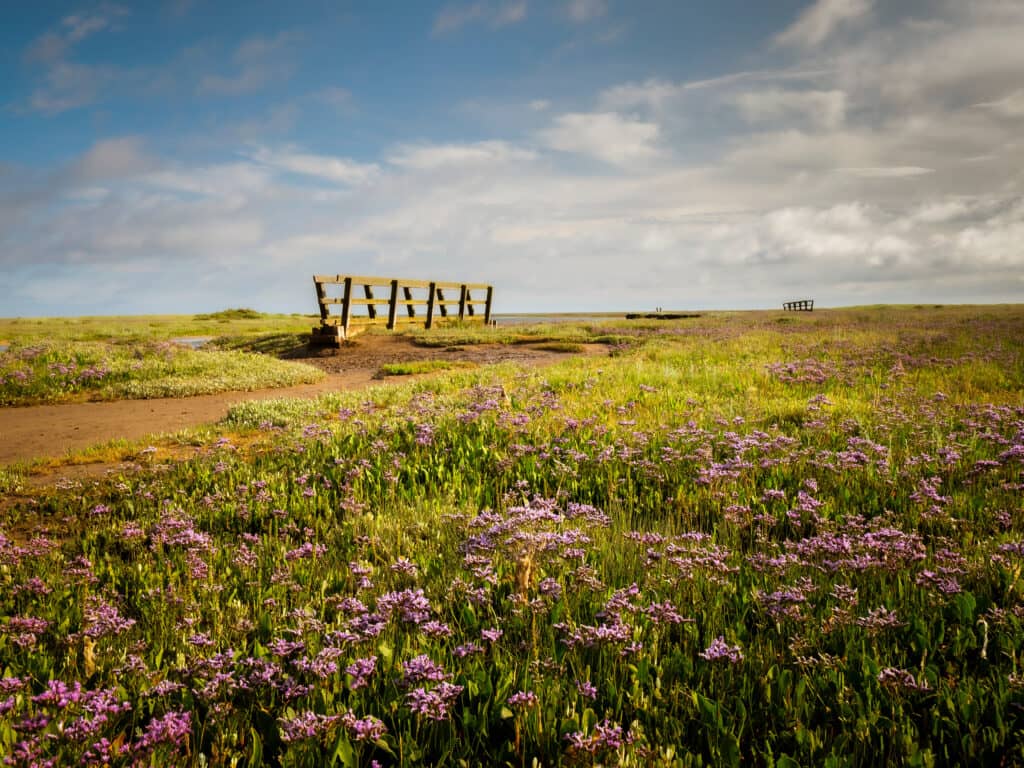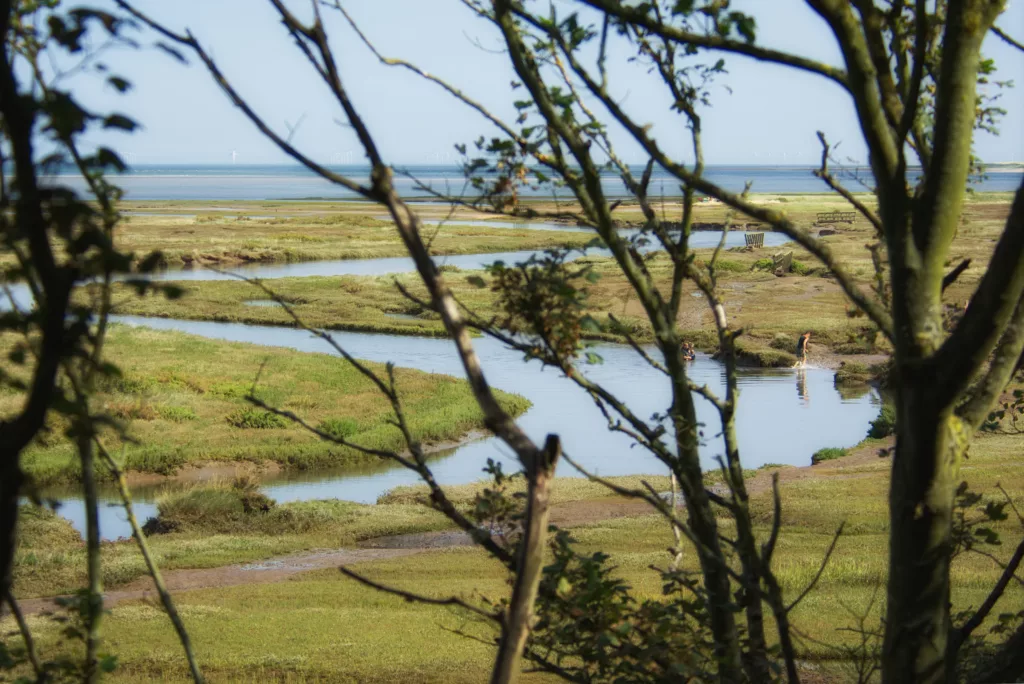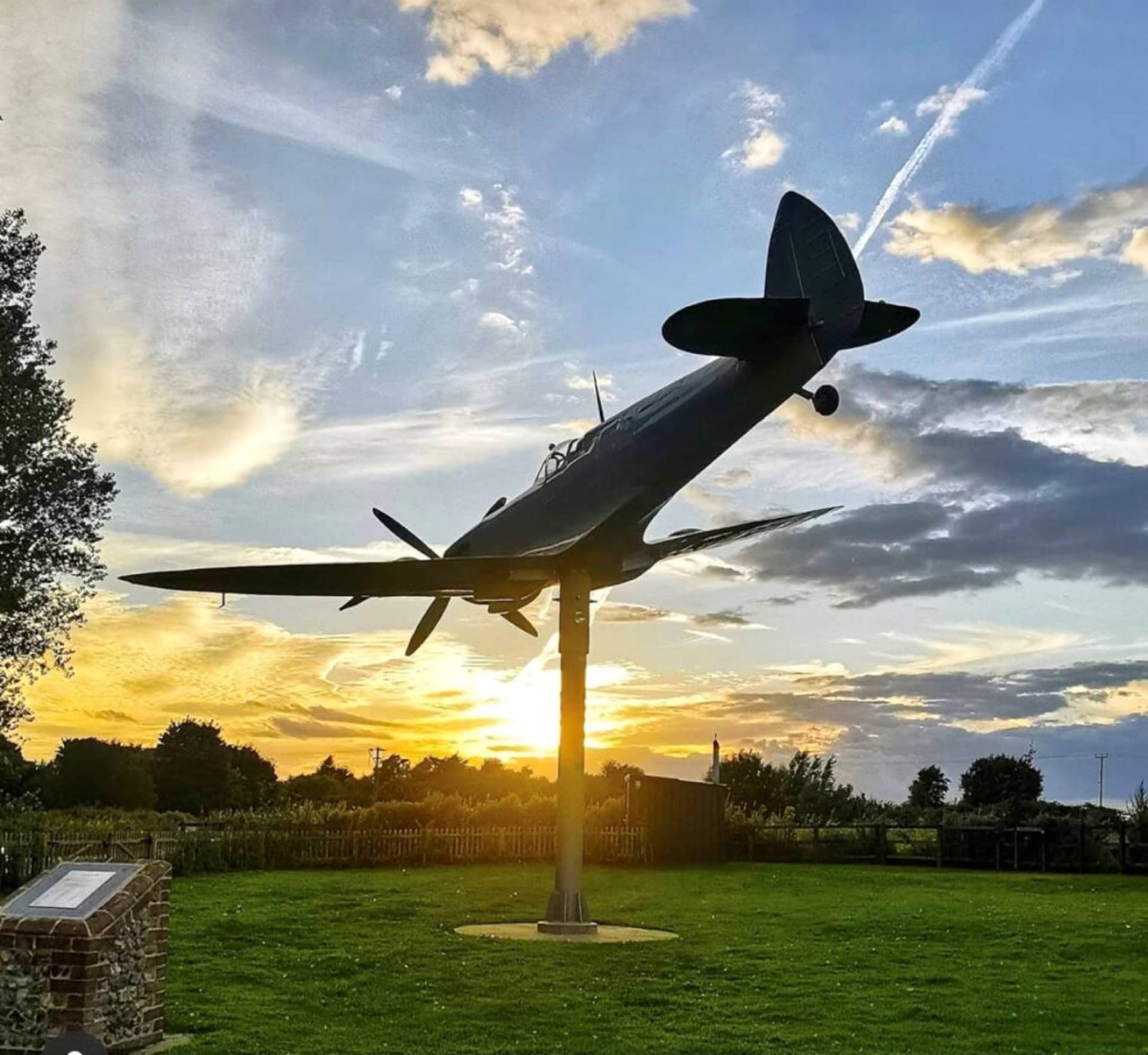
The Screaming Cockler of Stiffkey
The Stiffkey salt marshes are a magical world of glistening mud flats, rushing creeks and wheeling skies. The sandbanks are famous for ‘Stewkey blues’, reputedly the best cockle you’ll ever taste, a delicacy revered by chefs across England.
Stiffkey wasn’t built for cars, these narrow roads require polite patience! And when walking the coast path, Stiffkey is easy to miss. Unusually in a landscape known for wide expanses, the village is hidden in a deep green river valley, more akin to North Devon. Head south along the public right of way and over fields, down into the valley towards the fast-flowing river – one of only 200 chalk rivers in the world.
For all Stiffkey’s cosy charm, much of this land has been stolen from the North Sea and sometimes the sea claims a terrible revenge. A local tale tells of Nancy, a girl out cockling on the treacherous marsh. Banks of mist rolled in from the sea and she got lost, cut off by the fast rising tide. Villagers took to their boats as her terrified cries pierced the fog but the sound was distorted and no one could save her. Next day her body was found and she was buried at the local church. But many since have seen her ghost walk, roaming the Stewkey marshes on foggy nights, silence broken by her desperate screams.
Need a bit of comfort after that story?! The Stiffkey Stores serves delicious homemade cakes and exceptional coffee. Phew!

Bird Watching in Stiffkey Wood
The small North Norfolk coastal village of Stiffkey nestles between saltmarsh and deep river valley, reminiscent of Devon. A narrow band of woodland clings to the last vestiges of dry land before the saltmarsh stretches towards the sea. Stunted and aged by winter gales and salty winds the trees are battered, facing northerly lands. They are often the first landfall Norfolk’s world famous bird migrations in Spring and Autumn, when yellow browed warblers, shrikes and firecrests, blow in on winds from the east and north. Other species, like the woodcock, wait until the right moon. Author Henry Williamson lived in the village and wrote about the woodcock’s annual arrival to Stiffkey Wood.
‘It would be pleasant to be a bird-watcher for a year: to wander thoughtless through the calm sequent days of summer’s ending: mist at morning: pallid disc of sun: windless heat and light of pale blue heaven and yellow line of sand dimming to the small red smoulder of sunset: the strings of tired birds, arriving over the sea, and settling at once on the marshes and in the low sand-dunes.
Day after day of windless calm and of sunlight, serene and warm, as though all life were suspended on earth, save for the movement of wave and tide, the piping and passing of birds. The early autumnal days were the most beautiful for that soon the sea would be black, with white lines on shoal and sandbank, while the tractor driver on the hills fastened the sack closer round his waist, against the bitter winds. Soon through the mists would float the woodcock moon, pale and circular; and with the north-east wind would come those strange birds, with dead-leaf mottle plumage and long beaks and gentle brown eyes, flapping across the North Sea, from the forests of Norway, and the stone walls of cold fields above fiords in whose green, glissading depths great salmon moved to their spawning beds.
Soon the wind would arise, and the woodcock flights over the sea begin. Singly and twos and threes, while the moon moved up the sky wind-burnished and bright, with purple shine about its winter beginning, the woodcock would come darkly over the waves.’

Experience Wartime Norfolk at Langham Dome
Visit a small building with a big story! Langham Dome stands on the edge of RAF Langham, a decommissioned World War Two airfield which once revolutionised life in a peaceful Norfolk village. The intriguing curved structure housed state-of-the-art AA (anti-aircraft) training technology, schooling ground-to-air gunners using groundbreaking stop-frame film technology. Developed in 1940, it simulated attacks by projecting immersive images of enemy aircraft onto the Dome’s interior walls, like a Imax Cinema. Langham Dome is one of only six such WW2 gunnery trainers left, although 40 were built.
Today it’s a Scheduled Ancient Monument – reputedly the youngest ancient monument in the UK – owned by the North Norfolk Historic Buildings Trust. Supported by the Heritage Lottery Fund, the Trust and The Friends of Langham Dome (who preserve the building for future generations) have restored Langham Dome as a visitor centre to tell its fascinating stories of courage, sacrifice and ingenuity.
In 1939 Langham’s 200 residents lived in tiny flint cottages with no electricity or running water. By 1944 there were 2,500 people, united by a common struggle. Life centred around the new airfield where British men and women from all over the UK mingled with New Zealanders, Australians and Poles and other nationalities. The air was loud with dogfights and battling planes shot down over the sea while search lights swept the sky.
But that wasn’t the only noise! Wartime Langham became a swinging hotspot, where everyone let off steam at notoriously raucous parties!

The Fairies and Hytersprites of Blakeney
In the Middle Ages, along with Wiveton and Cley, Blakeney was one of the prosperous Glaven ports, sheltered by the long sandy spit of Blakeney Point, these busy harbours jostled with ships taking sheep and salt fish to the Low Countries. And when the Spanish Armada threatened England, the Glaven ports sent 36 ships to join Drake’s fleet. Eventually silt blocked the sea channels and only small nimble craft could navigate the marsh, the kind used by smugglers. It’s said beneath Blakeney’s narrow streets where so many old fishermen’s cottages are now second homes, there’s a maze of tunnels, created by gangs who once held sway along the North Norfolk coast.
But those underground labyrinths are home to even more elusive beings. Hikey Sprites or Hyter Sprites are rare creatures who haunt woods and marshlands at dusk, peculiar to Norfolk’s strange liminal places. Described by some as spider-like, scuttling on spindly legs, by others as flying on leathery wings, it’s said they’ll suck your blood and steal away children who wander out onto the marsh after dark. Parents warn ‘if you go out alone, the hyter sprites will get you’, though there are also folk tales of hikeys bringing lost children safely home. It seems, like faeries, sprites are nothing if not unpredictable.
Stories told by smugglers to scare off prying eyes? Or fables to safeguard curious children? Dare you to find out!

Seal Trips with Beans Boats
Across the world communities who live by the sea share legends of seals shifting to human form. And there is something strangely familiar about the gaze of these enchanting creatures from another world.
Operating in all seasons (except during boat maintenance in January and early February) Beans Boats is a family business with over 80 years of getting visitors up close and personal with one of Norfolk’s biggest Grey and Common seal colonies. The residents of Blakeney Point are often lolling about on the beach, calmly eyeing inquisitive humans just as we watch them. It’s important not to disturb them, so a guided boat trip is the best way to learn and make magical memories.
You’ll board one of five custom ferries at Morston Quay, head up Morston Creek and out into Blakeney Harbour. Relax and absorb the Norfolk’s wild beauty from the shelter of the harbour. Blakeney Point is one of Europe’s most important sites for migrating birds, so there’s loads to see on the way to the seal colony. The crew will share local history, passing the old Blakeney lifeboat station towards the tip of Blakeney Point.
Often a curious seal will pop its head from the waves right by the boat, as if checking the crew’s tales hold water! There’ll be plenty of opportunity for asking questions and taking photos, since the skilled crew will get in close without disturbing the seals’ peace. This is their world. It’s a great privilege to be guests here.
Build your own itinerary
If you fancy creating your own itinerary for a day trip to Norfolk or a longer visit, it couldn’t be simpler. Just go to Search Activities and select from our wide range of free and paid-for experiences, saving any that capture your imagination with the click of a button.
Once you’ve finished, you’ll find all the information stored in My Favourite, where you can drag and drop activities to create your own day-by-day itinerary! You can download this to a calendar and even share it with friends.
